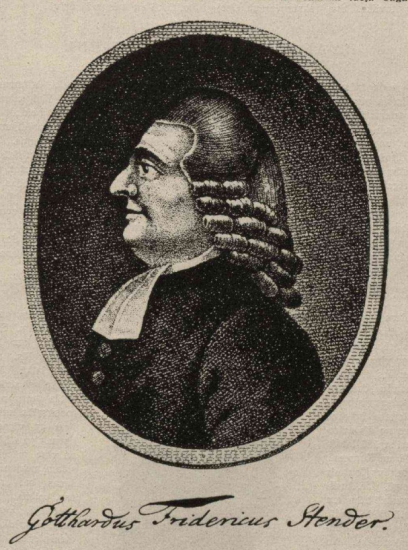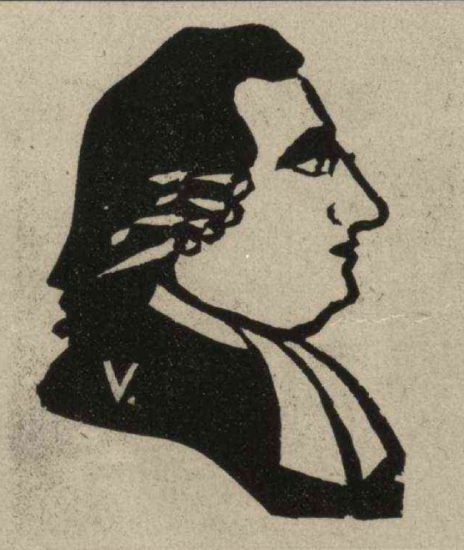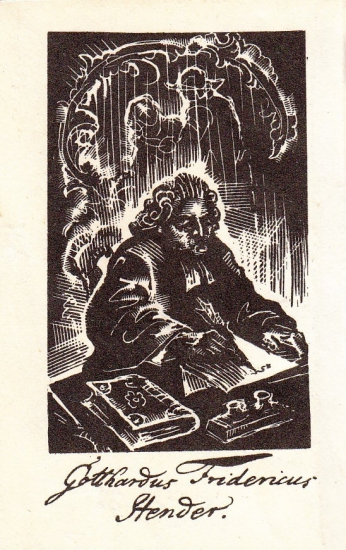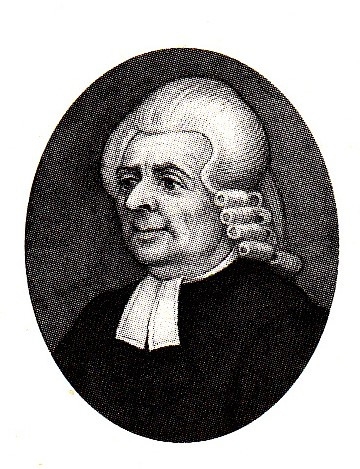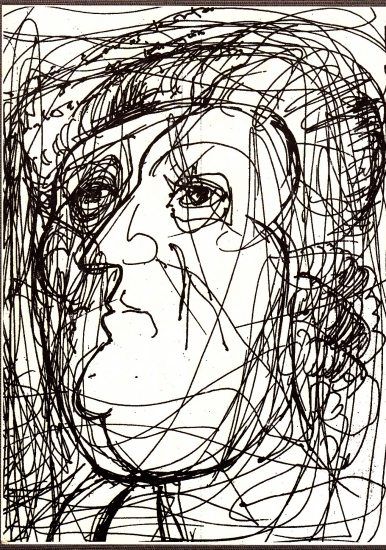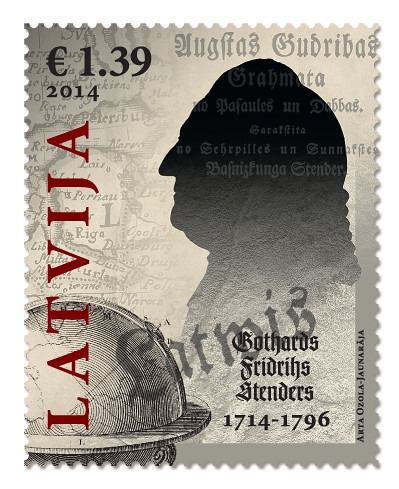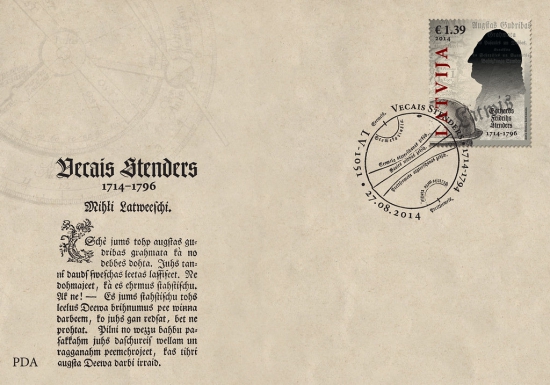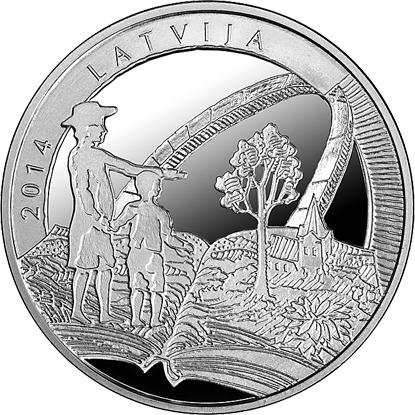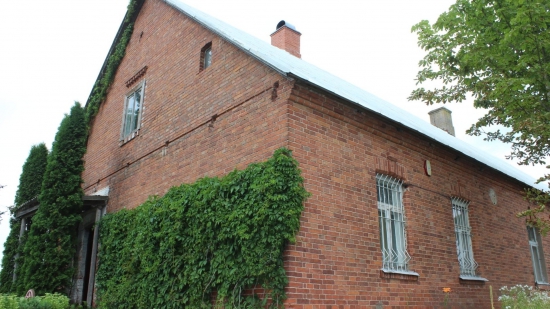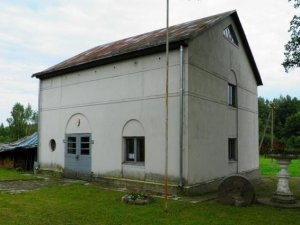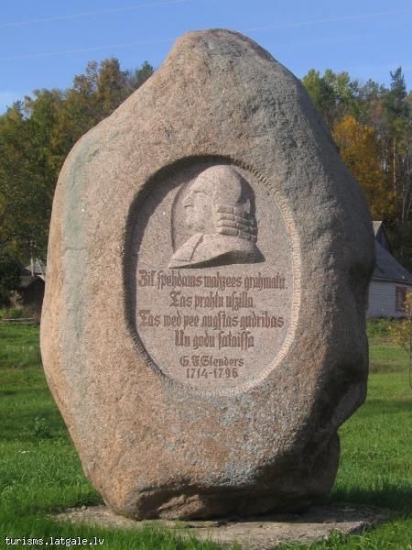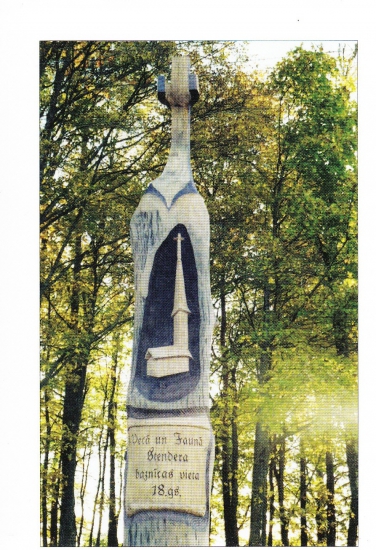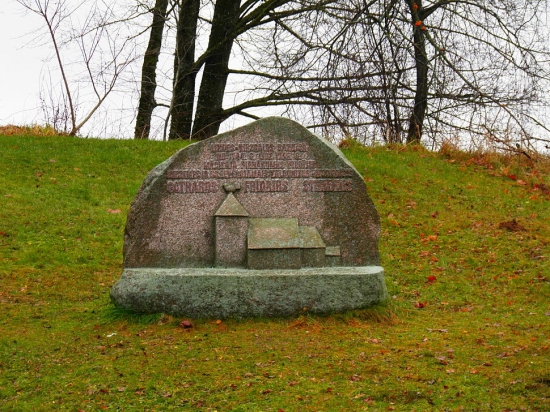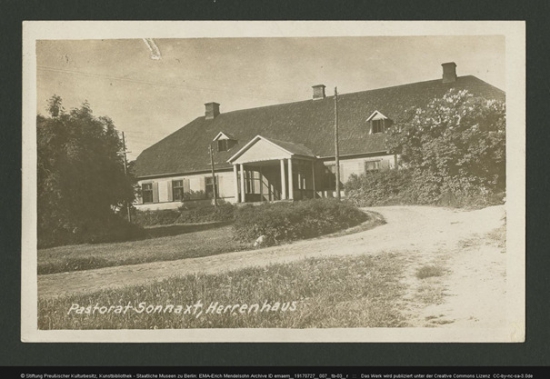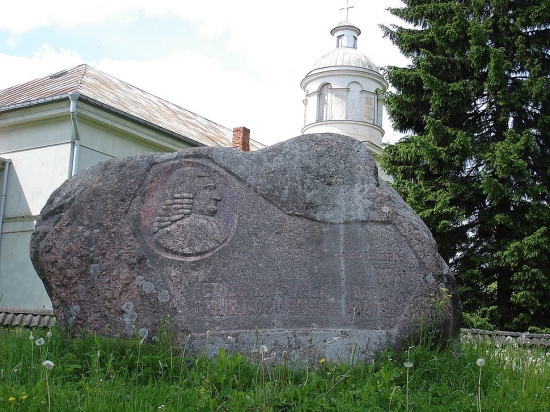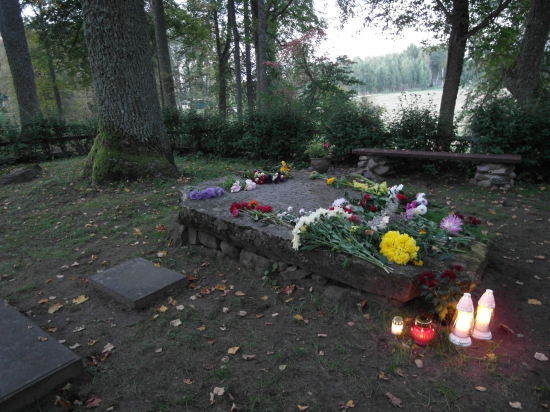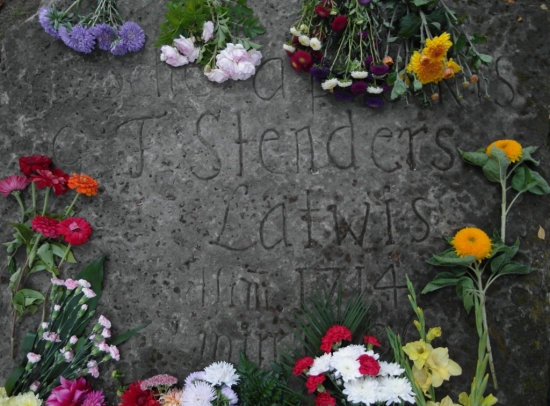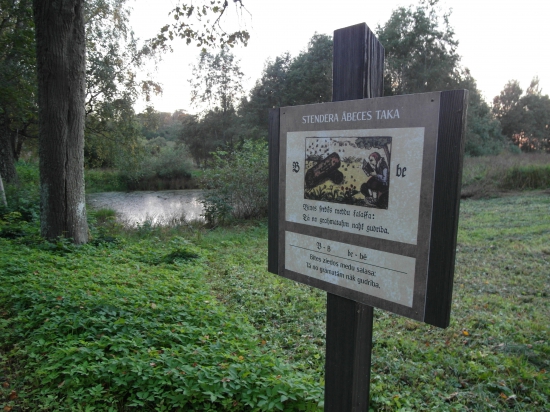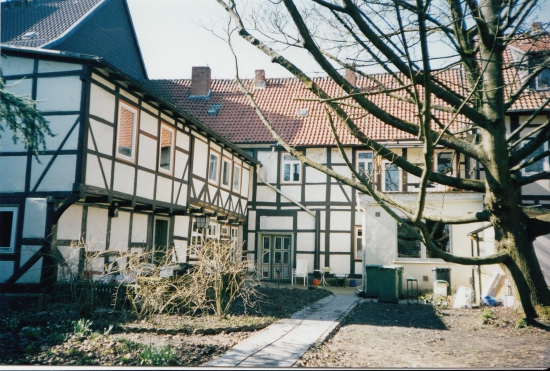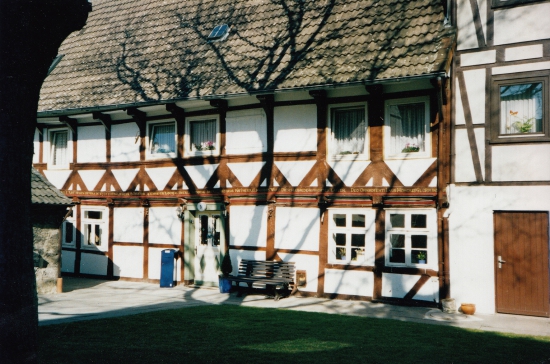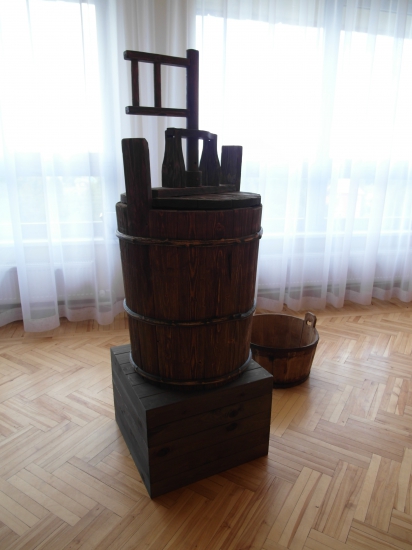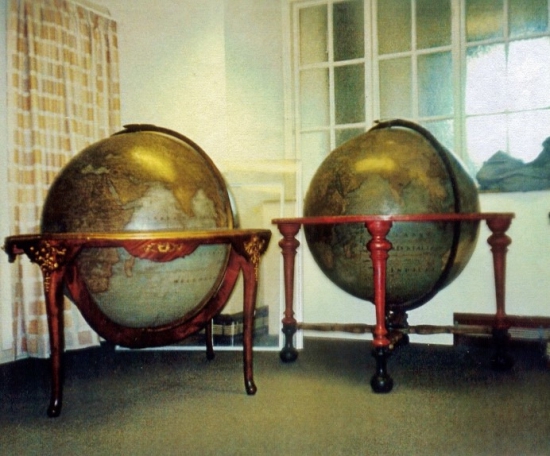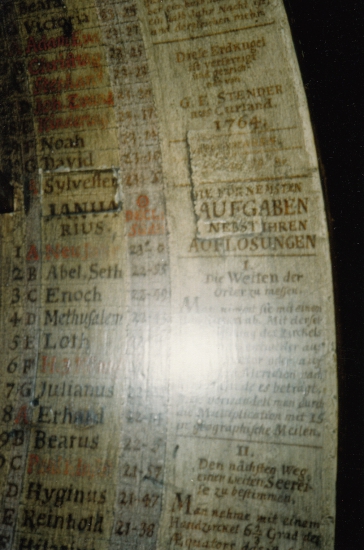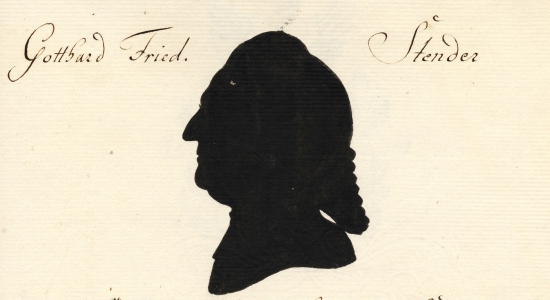Gothards Frīdrihs Stenders
27.08.1714 – 17.05.1796
Gotthard Friedrich Stender (1714-1796) was Baltic enlightener, a theologian, man of letters and linguist, a thinker, who was invested in the technical progress of the Enlightenment and the latests trends in pedagogy. Stender remained a supporter of moderate Enlightenment, believing that the written word and encouragement for education would promote not only the cultural ascent of his fellowmen, Latvians, but would also level the relationship between classes. Above all, credit must be given to him for the transfer of information from western Europe to the Baltics, from one social class to another, crossing the border of the German and Latvian language, as well. The Latvians owe their first encyclopaedia, first illustrated alphabet book, first books of secular poetry and short prose to Stender. The German counterparts of Stender’s works were rooted in the best fiction and textbooks of the time. The German youth of the Baltics might have used Stender’s books in Latvian as a tool for study and entertainment. Stender’s traces in the European society remain ambivalent. Though he referred to himself as a member of the Göttingen Royal Society, no documentary evidence has been found, same as with his position of a professor of geography in Copenhagen. Stender is known for his contacts with German and Russian Freemasons, but there is no evidence of his affiliation with the Masonic Lodge. Stender spent the final 30 years of his life on the outskirts of not only Europe, but also Courland, serving in churches in Selpils and Sunakste and writing scientific papers, studies in religious philosophy, as well as didactic and enlightening texts in German and Latvian.
Birth time/place
27.08.1714
Lašu mācītājmuiža
Dzimis mācītāja ģimenē
Place/time of death
17.05.1796
Sunākste
Acīmredzot nesatricināmi ticēdams Kurzemes kā latviskas vides nākotnei, Stenders izvēlas sava kapa uzrakstu "Latvis".
Personal information
The Stenders moved to Courland in the early 17th century. Gotthard Friedrich Stender was born in the family of pastor Hermann Conrad Stender and his wife Elisabeth Magdalena and had three brothers, two sisters and a stepbrother from his mother’s first marriage .
On February 4, 1744, in Jelgava, Stenders married Anna Elizabeth Braunschweig, the daughter of Andreas Wilhelm Braunschweig, pastor of Egypt (Vilkumiesta)and Žeime, and had five children:
1. Alexander Johann (1744-1819), known as the Young Stender, was a pastor and writer;
2. Eva Elizabeth (1745-1794), married in Copenhagen in 1765 to Christian von Schwentzen, captain of the Norwegian Danish army;
3. Johanna Dorothea (1746-1796), married Riga city auditor David Martin Knebusch in 1774;
4. Anna Magdalene Elizabeth (1749-?), married a wine merchant in Riga Johann Christoph Weyrich in 1768;
5. Johann Albrecht (1762-1765) was born and died in Copenhagen.
Some of so numerous descendants retained a keen interest in Latvian culture, for instance, the grandson, pastor and regional researcher Johann Christian Stender (1787-1862) and the grandson – pastor Carl Gottlieb Peter Stender (1830-1897), who started the tradition of Sunakste song festival. The last remaining member of the Stender family left Latvia during World War II.
Portraits of Stender
A silhouette cut made
in sepia technique is the only authentic profile made during Stender's lifetime
and included in J.Brotze's collection Sammlung verschiedener Liefländischer Monumente, IV, p. 218 in around 1792.
Most of the portraits featuring G.F. Stender in profile with expressive
facial features are made by with the help of engraving by Karl Traugott Riedel
(1769-1832) based on the drawing by Adam Christian Romminger. It was first
published in the first history of Latvian literature: U.Zimmermann. Versuch einer Geschichte
der lettischen Literatur. Riga, 1812.
Contemporaries have noted that this portrait looks nothing like Stender.
Professional activity
Stender worked as a
pastor, in his youth - in Jelgava, later in Königsluther and possibly in
Copenhagen, where he also worked as a teacher. Stender was interested in the
latest trends and achievements in literary and scientific development, wrote
for German periodicals published in the Baltics and Western Europe, published
books in the Baltics and Western Europe in German, Latin and Latvian. In his
later years, he became fascinated with alchemy and there is the remaining manuscript
on Clavis
magiae. Die geheime Naturweisheit ("Secret Wisdom of Nature", 1794) complemented by an alchemy
dictionary.
1753: the first
publication – “Peaceful Weather after the Danger of Thunder”, the translation of
German author Bartold Heinrich Brockes’ work Die auf ein starkes Ungewitter erfolgte
Stille into Latvian printed
in Königsberg.
Stender was writing poetry that was philosophically religious, didactic,
entertaining, sincerely sentimental, in German and in Latvian, literally and
freely translated, paraphrased and varied, dedicated to Courland court people, both
Germans and Latvians, and to his relatives. The first edition of the last poem
comes out already after the author's death in 1797 - "The Drinker",
published in "Latvian Year Book", Issue 1.("Latviskās Gada Grāmatas" )
Literary activity
Prose
1756: "Sacred Stories", hereinafter called "The Little Bible. That is: Sacred Stories" (1790, 1882: Ed. 6). 52 Old Testament and 52 New Testament stories complemented by brief questions and a didactic poem are briefly set out. The publication was inspired by the work of German educator Johann Hübner - Zweymal zwey und funffzig Auserlesene Biblische Historien, der Jugend zum Besten abgefasset (1714). Novelty - the first book of faith teaching in Latvian. The genre is continued by a collection of Bible stories, catechism, spiritual songs and a prayer book "The Christian Teaching Book for the Latvians about the Sacred Interpretation" (1776). This book was revised by Alexander Johann Stender and this edition experienced several re-prints (1807, 1841, 1850).
1766: Fabeln und Erzählungen / "Fables and stories", supplemented edition "Fairy Tales and Stories" (1789), the book contains fables, joke tales and everyday stories written in poetry and prose, most of the stories borrowed from German sources. Novelty - the first book of fiction in Latvian.
Poetry
G.F. Stender enters Latvian poetry with the translation of B.H.Brokes' ode (1753), which was followed mainly by the translations of German-language spiritual songs and secular poetry, incl. odes, fables and songs. These translations were published both in periodicals (calendars), in hymnals, and in various Stenders' non-fictional works (grammar book, popular science book "The Book of High Wisdom, etc.").
1754: "Kurzeme's new and complete hymnal" – Stender was one of the compilers, poet, editor, illustrator.
1774: " New ziņģes/songs with lovely tunes for jovial entertainment", supplemented edition - " Jolly ziņģes " (1-2, 1783-89), includes translations of the 18th century German poets (Chr. F. Gellert, J. W. L. Gleim, von Hagedorn, etc.), and possibly also Stender's own writings on countryside life, love, schooling, social class relationships, etc. written in a rustically didactic manner. Novelty - the first collection of Latvian secular poetry, in the 19th century several zinģes/ popular songs have folklorized.
1774: "The Book of Holy Wisdom", a compilation of spiritual texts, including the translation of Johann Caspar Lavater’s work Christliches Handbüchlein, oder auslesene Stellen der heiligen Schrift (Christian Handbook or selected passages from the Holy Scriptures, 1767), as well as Carl Wilhelm Ramler's and Carl Heinrich Graun's cantata Der Tod Jesu (The Death of Jesus, 1755).
1781: "New Year's Wishes for Everyone" - The first collection of greeting poems in Latvian.
1781: Katechismus in Versen (“Catechism written in rhythmical prose"), as Stender himself stated in the title, is for rural youth. It also contains instructions for daily life in 56 four-line verses, which Stender translated as "The Path to a Righteous Living" in Latvian. The collection is also published in Latin Catechismus melicus Latinis christianorum scholis dictatus (1782).
1783: "A New Hymnal with commnets" (II d.1792) – the hymnal infused with rationalism, arranged and translated by Stender.
1787: An seine Kinder und Enkel, bei der nahen Trennung von seiner Tochter "For my children and grandchildren on the occasion of the upcoming separation from my daughter" - an ode which Stender translated into Latvian "The High Song for the children and grandchildren" and published in the poetry collection of 1789.
1789: " Elisa’s twelve sacred songs, translated into Latvian" - the collection contains the spiritual poetry of Courland landlady Elisa von der Recke, Stender translated all the texts of XII.von Elisens geistlichen Liedern beym Clavier zu singen (1787) edition. The book, like its German edition, is dedicated to the Duchess of Courland, Dorothea. Novelty: the first rendition of the Baltic German poetry collection into Latvian.
Linguistics
1761: Neue vollständigere lettische Grammatik ("Jauna pilnīgāka latviešu gramatika"), pievienota vārdnīca un daži dzejoļi. 1763 atkārtots izdevums;1783 Lettische Grammatik ("Latviešu gramatika") - paplašināts un papildināts izdevums, vārdnīcas nav, dzejas nodaļai cits saturs. Grāmatā Stenders atklāj savu viedokli par latviešu valodas izcelšanos un radu valodām, tajā ietverta nodaļa par poēziju, tajā raksturotas latviešu tautasdziesmas kā latviešu dzejas mākslas sākotne; grāmatā publicēts latviešu mitoloģisko dievību saraksts un sakāmvārdi, kā arī divi dzejoļi - Stendera mēģinājumi dzejot tautasdziesmu garā. Grāmata tulkota un publicēta latviski (2015).
1789: Lettisches Lexikon. In zween Theilen abgefasset und den Liebhabern der lettischen Literatur gewidmet ("Latviešu leksikons. Izveidots divās daļās un veltīts latviešu literatūras cienītājiem", otrais izdevums 1790). Pirmajā - latviešu vācu daļā - pēc ligzdu sistēmas apkopoti 7000 vārdi, otrajā - vācu latviešu daļā - apmēram 14.000 vārdu. Novitāte: pirmoreiz pievienoti arī ģeogrāfisko vietu, personvārdu, augu, dzīvnieku utml. vācu-latviešu nosaukumu saraksti, populārākā 18.gadsimta latviešu valodas vārdnīca, plaši izmantota (Rainis, Brīvzemnieks u.c.) un pētīta (A.Bīlenšteins, J.Endzelīns).
Religious philosophical literature
1771: Gedanken über die Lavaterische Aussichten in die Ewigkeit ("Thoughts on Lavater's view of eternity") - an anonymously published theological polemics in letters with the Swiss poet and physiognomist Johann Caspar Lavater’s work Aussichten in die Ewigkeit (1 – 4, 1768-1778). The publication of Stender's work was followed by an exchange of letters between Lavater and Stender.
1772: Wahrheit der Religion wider den Unglauben der Freigeister und Naturalisten ("The Truth of Religion against the Infidelity of Free-thinkers and Naturalists", 1772, reprint in 1784) is Stender's main religious philosophical essay. Its first draft was written in Copenhagen (1765), the manuscript is kept in the library of the University of Göttingen. The work was published twice in Russian (1785, 1820), and it explored issues of world cognition, free thinking, and spiritual growth. It resonates with the Enlightenment theological rationalist and Freemasonry ideas and was referred to in Rosicrucian works and is included in the German Freemasonry bibliographic index, and has also aroused interest among Russian freemasonry circles. The book polemizes ideas of free thinking, and reveals Stender's reflections on the potential for spiritual growth in "The Book of Sacred Wisdom" (1774), "The Christian Teaching Book is written for the Latvians for sacred interpretation" (1776), "Katechismus in Versen", (Catechism in Verses, 1781), "New Year's Wishes for Everybody" (1782), "Gedanken eines Greises uber den nahen Zustand jenseit des Grabes" (The old man's thoughts on the approaching afterlife”, 1786), "The aid for the schoolmasters that with this the new ABC they can easily teach schoolchildren to read"(1797).
1784: Mosaische Kosmogonie (Moses Cosmogony) - publication in Mitauische Monatschrift, No. 4 on the Origin of the World – the Old Testament in the context of natural science ideas of Enlightenment.
1786: Gedanken eines Greises über den nahen Zustand jenseit des Grabes , (“The old man's thoughts on the approaching afterlife”), in 1795 Stender publishes an addendum to this work Philosophische Gedanken über wichtige Gegenstände, als Beilagen. ( “Philosophical thoughts on important notions, an appendix”). A year later, Stenders returns to these ideas and adds the ode Der erhabene Lobgesang Gottes zur allgemeinen Gottesverehrung als eine Beilage zu den philosophischen Gedanken ("A song of glorification of God for praise of God as a supplement to philosophical thought "), in fact, a free translation of the song Herr Gott. dich loben wir (Lord, we praise you).
1786-1787: Discussion with Jelgava Academia Petrina professor Johann Melchior Gottlieb Beseke on God and the divine manifestations in nature Anmerkungen über die Offenbarung Gottes in der Natur un Anmerkungen über die Gegenarmenkungen des Verfassers Der Offenbarung Gottes in der Natur.
Science
1764: Der Schulzische Vorschlag die Meereslänge zu finden /Schulzianum inveniendi maris longitudinem (On Schulz's proposal for the measurement of sea distances) – in collaboration with inventor Johann Heinrich Schulz – the description of a new instrument for measuring distances on water, title and text in Latin and German with Stender’s drawings.
1765: Beschreibung der neuen höchstbequemen Waschmaschine ("Description of the new extremely comfortable washing machine") published almost simultaneously in a separate booklet in Jelgava and Königsberg, in Gelehrte und politische Zeitungen (1765, St.56), soon reviewed in the Braunschweig newspapers and re-published in Berlinisches Magazin in Berlin (1766, Bd.3, St.3, S.268-275). Novelty: the first description of mechanical laundry in a German-speaking space.
1766: Beschreibung der neuen Erdkugel ("Description of the New Globe"), similar publication as early as November 14, 1759. in the newspaper Braunschweigische Anzeigen ("Braunschweig News"). Stender put his theoretical knowledge into practice, making several globes, two of which have survived: the globes for the King of Denmark and the Royal Library are today in the Royal Library in Copenhagen.
Textbooks
1774: "The Book of High Wisdom from the
World and Nature", reprinted in 1776, with supplemented edition in 1796. The
latter was edited by Alexander Johann Stender. It is an encyclopedic
publication on the geography and history of the world, on astronomy and
physical processes, on natural phenomena, and on the measurement of time targeting
readers with poor background knowledge. The presentation of ideas employs
methods of Enlightenment pedagogy, possibly drawing on Stender’s experience of
a geography teacher acquired in Copenhagen. Thanks to its transparent structure
and easy-to-read content, the book is also believed to have been read by Baltic
German youth and is one of the most frequently cited editions among Latvian
first-generation intelligence (Ansis Leitāns, Ernests Dinsbergs, etc.). The
cover of the second edition, engraved by Gustav George Ender - a teacher
showing to the boy the rising sun - has become a symbol of the Latvian
Enlightenment.
1782:
"A New ABC and reading aid". The ABC is complemented by "A
Roadmap to Righteous Living"; part two of the book provides methodological
guidance for teachers in reading literacy. In 1797 each part is published again
separately. Novelty - the first methodical aid in Latvian.
1787: "Picture ABC" - Each letter of
the alphabet has its own illustration, prepared on the basis of Stender’s drawings,
and an instructive poem. Novelty - the first illustrated alphabet in Latvian.
Reception
2019: Björn Spiekermann: "So ist oftmals Vernunft wider Vernunft". Gotthard Friedrich
Stenders Verteidigung der christlichen Religion im Horizont der deutschen Spätaufklärung. Baltisch-deutsche
Kulturbeziehungen vom 16. bis 19. Jahrhundert. Medien-Institutionen-Akteure.
Bd.II Zwischen Aufklärung und nationalen Erwachen. Heidelberg:
Universitätverlag Winter, S.155-199.
Quotes
"To you, Honourable old pastor / and the Latvian educator!
We convey this song of honour.
And on the second day of birth / Above the eighty
We're all rejoice already.
Landlords - fathers - / With young - school children
Bow to You/ And lift up hands to the sky.
* * * * *
For all your books / Written to profess good news
God be enough for you.
How many doctrines are in them / Of true holy wisdom
May God make your days longer.
Heartily - words / What you said - and wrote
People will clarify: / And the heaven will enhance the happiness for you.
* * * * *
And when even at a great age / Your spirit persists in the body,
But you get tired of old house.
Then let that dear soul / Rise up like a new star
And walks light feet.
All - Holy - / Father & Mother - Brother & Sister-
Whoever is in front of you / will lead you in with honour. "
Alexander Johann Stender. XIV. A song of honour on the 82nd and the last birthday of old Stender, sung by the children from Warrenbrock School. Tune. May you get a nice morning light. in: A.J.Stenders. Songs, story songs, fairy tales, etc. for the Latvians on being joyous and raising their minds. Jelgava: J. F. Steffenhagen und Sohn, 1805, pp. 42-43.
"It was as if Widewuto was the first to gather Latvians from the woods by calling out to the plains, calling together in groups, setting laws, / as the first to unite them in their humanity; so Stender, by reading silver sounds/ words rippling from their lips, strung them in a string, and was the first to unite the Latvians as a nation. " Auseklis. Videvuts un Stenders. Ausekļa Kopoti raksti. Rīga: A.Gulbis, [b.g.], 195.pp
"To these despised Latvians yourself / Sincerely, You got attached,
Without prejudice, "Old Latvian" will remain.
Now, where in a hundred years / Since you rest in the sand,
Free Latvians, for holy horror / Commemorate your efforts.
As with the long rays of light / Light you stroke for Latvians,
For these deeds You will forever / be remembered...
[Kr. Alder-Zundulis] A.Z. To the grave of Old Stender. Patriotic Calendar for 1899. Riga: E.Platess, 1898, p.33.
"We celebrate Old Stender, who deeply / Loved the singing Latvian people,
Coming as a stranger in the lower Daugava / Harvesting Latvian words
In the smart books carefully together, / Calling to awakening, and the path of knowledge,
Praising virtues, the people keep.
You wanted to engrave on your gravestone / your beloved word: Latvian! "
Jānis Akuraters. Dzejnieku cildinājums. Fragments. Jaunākās Ziņas, 1935, No.256.
"Old Stender was a highly educated man but showed no unusual innate ability in any industry. In contrast, he possessed what Skalbe called "work ingenuity"- endless agility and diligence in performing certain tasks. This is how he secured his impressive place in the history of our literature, language research and pedagogy. "
Andrey Johansson. Latviešu literātūra. Stokholma: Trīs zvaigznes, 1953, 47.pp.
"The Stender name evokes an era characterized by both the glitter of ancient wigs, the bitterness of the Latvian people's life, and the vision of new horizons.
Zigrid Fried. Latvian. Gothard Friedrich Stender. Riga: Science, 2003, 4th cover.
"The High Wisdom Book" can be called the first Latvian encyclopaedia of natural sciences, retaining its position for almost 100 years, it was read, in their childhood, by K. Valdemārs and A.Pumpurs, E.Dinsberģis and brothers Kaudzītes. More broadly, it can be seen as the first encyclopaedia of peasant serfs, as "peasant physics" (Bauernphysik), as described by F.K. Gadebusch in his lexicon and also Swiss Lafater, it was a unique achievement even on a European scale, at least our neighbours had none of a kind." Jānis Stradiņš. Zinātnes un augstskolu sākotne Latvijā. Rīga: Latvijas Vēstures institūta apgāds, 2009, p. 239.
"Old Stender insisted that poetry first and foremost has to convey clear and useful thoughts. It largely explains his intolerably instructive stance: he never misses an opportunity to moralize." Guntis Berelis. Latviešu literatūras vēsture no pirmajiem rakstiem līdz 1999. gadam. Rīga: Zvaigzne ABC, 1999, p.16
Affinities
Occupations
Name at birth
Gotthard Friedrich Stender
Pseudonym
Vecais Stenders, G.F.S., G.F.St., St.
Education
Jaunsubates vācu skola
Subate
Mācījies Īzāka Bauera (Bauer) vadītajā skolā.
1736–1739
Friedrich-Schiller-University Jena
Jēna
Studējis filozofiju un teoloģiju.
1736–1739
University of Halle
Halle
Studējis teoloģiju, senās valodas un retoriku, strādājis bāreņu patversmē par skolotāju
Memorials
Eglaine local community center of history. Museum of Old Stender
Lašu mācītājmuiža
1989. gadā G.F.Stendera muzejs iekārtots bijušās Lašu mācītājmuižas (ēkas, kurā ir dzimis Stenders) vēsturiskajā galā. Daļa no muzeja ekspozīcijas izvietota arī turpat blakus esošajā mācītājmuižas klētī. Ekspozīcija veltīta novadpētniecībai un Stenderu dzimtas piemiņai.
Sunākstes Baltā baznīca
1989. gadā pie Sunākstes Baltās baznīcas novietots G.F.Stendera piemiņas akmens. Vieta ir simboliska, atrodas blakus Sunākstes vecajiem kapiem ar Stenderu kapu kalniņu. Baznīca celta 19. gadsimta sākumā. Šajā ēkā G.F.Stenders nekad nav strādājis
Sunākstes baznīcas kapi
Kapu centrā ir Stenderu kalniņš, kurā apbedīti G.F.Stenders, viņa sieva un dēls A.J.Stenders. Uz G.F.Stendera kapa novietota plāksne, uz kuras, izpildot viņa vēlēšanos, iegravēts vārds "Latvis".
Sunākstes mācītājmuiža
No Sunākstes Baltās baznīcas uz bijušās Sunākstes mācītājmuižas vietu, pieminot G.F.Stenderu kā pedagogu, ved "Bildu ābices" taka, kas izveidota 2014. gadā, izmantojot ilustrācijas un tekstus no pirmās ilustrētās ābeces latviešu valodā.Mācītājmuiža pamazām sagruva pēc 21.gadsimta sākumā. Šobrīd redzami tikai tās pamati. Mācītājmuiža bija saistīta ar Stenderu dzimtas vārdu no 18. gadsimta līdz 20. gadsimta sākumam, tajā dzīvoja arī G.F.Stenders un viņa dēls.
1923
Stendera iela, Rīga
Par godu G.F.Stenderam iela nosaukta 1923. gadā, pēc tam ielas nosaukums nekad nav mainīts. Tā atrodas Mežparka rajonā Rīgā.
1989
Piemiņas akmens G.F.Stenderam, Eglaines pagasts
Piemiņas akmens G.F.Stenderam atrodas Neretas - Ilūkstes ceļa malā Eglaines pagastā. Tēlnieks I.Folkmanis, arhitekte N.Tamane. Piemiņas akmens uzstādīts 1989. gadā sakarā ar 275. Stendera dzimšanas dienu, kā arī to, ka viņš dzimis bijušajā Lašu mācītājmuižā, kas šobrīd atrodas Eglainē.
1989
Birzgale
1989. gadā uzstādīta piemiņas zīme (skulptors O.Feldbergs) Birzgales baznīckalnā par godu 1965. gadā nopostītajai Birzgales baznīcai, kurā kā Birzgales Lindes draudzes mācītājs no 1744. gada līdz 1753. gadam sprediķoja G.F.Stenders.
2004
Sēlpils un Sunākstes draudzes baznīca
Koka piemiņas zīme mākslinieku brāļu Rūrānu darbs, tika uzstādīta 2004. gadā, taču līdz mūsu dienām nav saglabājusies. Tā atradās pie "Zvanītāju" mājām, vietā, kur no 1742. gada līdz 1816. gadam atradās Sēlpils un Sunākstes draudzes baznīca. Tajā sprediķoja G.F.Stenders un vēlāk viņa dēls A.J.Stenders.
09.2014
National Library of Latvia
Mūkusalas iela 3, Rīga
G.F. Stendera lasītava Latvijas Nacionālajā bibliotēkā tika izveidota G.F.Stendera piemiņas saglabāšanai LNB jaunās ēkas un G.F.Stendera 300.jubilejas gadā. Tajā neliela pastāvīga ekspozīcija iepazīstina ar atsevišķiem G.F.Stendera darbiem un portretu.
20.07.2017
Stendera biedrība
Antonijas iela 1, Rīga
2017. gadā dibinātās Stendera biedrības viens no galvenajiem mērķiem ir G.F.Stendera vārda un ideju popularizēšana, kā arī G.F.Stendera piemiņas saglabāšana. Biedrība ir G.F.Stendera kultūrvēsturiskā mantojuma Sunākstē uzturētāja un finansiāla atbalstītāja, kā arī izdevumu, kas saistīti ar Sēlijas kultūru un G.F.Stendera dzīves un darbu izpēti, atbalstītāja.
Working place
1740–1742
Lielbērsteles muiža
Stenders strādājis par mājskolotāju barona fon Grothusa (von Grotthuß) ģimenē.
1742–1744
Jelgavas reālskola
Lielā iela, Jelgava
Strādā par Jelgavas Lielās pilsētas skolas skolotāju, rektora Johana Jākoba Mačevska (Maczewski) palīgu jeb konrektoru..
1744–1753
Birzgale Parish
Birzgale
Strādājis par mācītāju, 26. 09. 1752. piedzīvo ugunsgrēku mācītājmuižā.
1753–1759
Žeimes luterāņu draudze
Žeimele
Strādājis par mācītāju luterāņu draudzē
07.1760–03.1761
Kēnigslutera
Strādājis par skolotāju jaundibinātajā reālskolā. Uzskatu atšķirību dēļ ar mācītāju Arnoldu Antonu Cviki (Zwicke) no darba atstājies.
1766–1769
Parish of Selburg and Sonnaxt
Sēlpils un Sunākstes draudzes baznīca
Stenders kalpo kā palīgmācītājs.
1769–1796
Parish of Selburg and Sonnaxt
Sēlpils un Sunākstes draudzes baznīca
Stenders kalpo kā draudzes mācītājs un dažus gadus arī Sēlpils iecirkņa prāvests (1782-1787)
Residence
1759–1760
Helmštete
Pagatavo Braunšveigas Līneburgas hercogam globusu un publicē rakstu avīzē Braunschweigische Anzeigen (1759, nr.84,85,87) par audzināšanas jautājumiem.
07.1760–03.1761
Kēnigslutera
Dzīvo pilsētas rātes aptiekas mājas II stāvā: Niedersächsisches Staatsarchiv Wolfenbüttel, 4 Alt 3 Stift Königslutter, 1504; 8.VIII, 1760.
03.1761–01.1762
Hamburga
Stenders ar ģimeni 18. martā izceļo no Kēnigsluteras un pēc tam dzīvo Hamburgā - vai nu līdz 1761.gada vēlam rudenim, vai 1762. gada janvārim, iespējams, Hamburgā Stenders ar Krievijas sūtņa Dānijā Johana Albrehta Korfa starpniecību un ieteikumu saņem Dānijas karaļa pasūtījumu izgatavot globusus.
01.1762–04.1765
Kopenhāgena
Stenders ar ģimeni uzturas Kopenhāgenā. Nāk pasaulē dēls Johans Albrehts Stenders (8.02.1762-17.02.1765) - reģistrēts Kopenhāgenas Pētera (vācu) draudzē. G..Stenders pagatavo divus globusus Karaliskajai bibliotēkai un Dānijas karalim un strādā par ģeogrāfijas skolotāju, iespējams kadetu skolā.
1766–1796
Sunākstes mācītājmuiža
Travelled
18.03.1761
Hamburga
Stenders ar ģimeni izceļo no Kēnigsluteras uz Hamburgu. Hamburgā uzturas līdz 1761. gada vēlam rudenim vai 1762. gada janvārim.
05.05.1765
Sanktpēterburga
Stenders kopā ar ģimeni ierodas Pēterburgā (viņam ir J.A.Korfa ieteikuma vēstule), iespējams ar cerību kļūt par Krievijas Zinātņu akadēmijas biedru. No: Peter Hoffmann,
Valerij Ivanovič Osipov (Hrsg.). Geographie, Geschichte und Bildungswesen in
Rußland und Deutschland im 18.Jahrhundert. Briefwechsel Anton Friedrich
Büsching – Gerhard Friedrich Müller 1751 bis 1783. – Berlin: Akademie Verlag,
1995. S.293-294.
Buried
05.1796
Sunākstes baznīcas kapi
Apglabāts Sunākstes vecajā kapsētā pie Sunākstes baznīcas, uz kapa plāksnē iegravēts vārds "Latvis".
